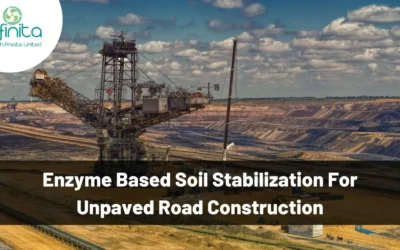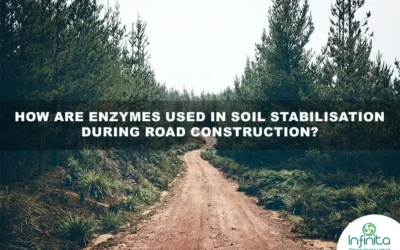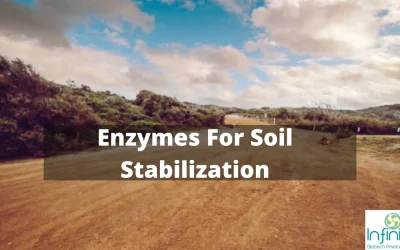Soil stabilization is an essential process in construction that not only provides structural support but also offers numerous environmental benefits. By understanding the concept of soil stabilization and its role in construction, we can better comprehend its impact on the environment. Additionally, by exploring the connection between soil erosion and climate change, we can appreciate the importance of implementing eco-friendly solutions like soil stabilization. In this article, we will delve into the science behind soil stabilization, the different methods used, and its potential future innovations.
Understanding Soil Stabilization
Definition and Process of Soil Stabilization
Soil stabilization involves enhancing the properties of soil to improve its strength, durability, and load-bearing capacity. It transforms unstable or weak soil into a stable and robust material suitable for various engineering applications. The process typically includes altering the physical, chemical, or mechanical properties of the soil to enhance its stability.
The process of soil stabilization may involve adding chemical agents, such as cement, lime, or fly ash, to bind the soil particles together and increase cohesion. It can also involve mechanical methods, like compaction or reinforcement, to improve the soil’s load-bearing properties.
Soil stabilization is a versatile technique that can be tailored to suit different soil types and project requirements. For cohesive soils with high clay content, chemical stabilization using lime can effectively alter the soil structure and improve its load-bearing capacity. On the other hand, granular soils may benefit more from mechanical stabilization techniques like compaction, which increases soil density and reduces settlement.
The Role of Soil Stabilization in Construction
In construction, soil stabilization plays a crucial role in ensuring the longevity and stability of structures. By stabilizing the soil beneath foundations, roads, and embankments, it reduces the risk of settlement, deformation, or collapse.
Stabilized soil also provides a cost-effective alternative to traditional construction approaches. By utilizing locally available materials and minimizing the need for extensive earthwork, it reduces construction costs and environmental impacts.
Furthermore, soil stabilization can significantly accelerate construction schedules by allowing for faster foundation preparation and reduced curing times for stabilized soil layers. This time-saving aspect is particularly beneficial in projects with tight deadlines or in regions with adverse weather conditions that limit construction windows.
The Environmental Impact of Soil Erosion
How Soil Erosion Affects the Environment
Soil erosion, the removal of topsoil, poses significant environmental challenges. It leads to loss of fertile soil, decreased agricultural productivity, and increased water pollution. Additionally, erosion can result in sedimentation of water bodies, impacting aquatic ecosystems and compromising water quality.
Moreover, soil erosion exacerbates the effects of climate change. As topsoil is eroded, valuable organic matter and carbon are lost, contributing to increased greenhouse gas emissions. The loss of vegetation cover due to erosion also reduces carbon sequestration capacity and exacerbates the impacts of droughts and floods.
One often overlooked consequence of soil erosion is the disruption of nutrient cycling. Topsoil, rich in essential nutrients for plant growth, is gradually washed away, leading to nutrient depletion in the remaining soil. This depletion can result in decreased crop yields and the need for additional fertilizers, which can further contribute to environmental degradation through chemical runoff.
Furthermore, soil erosion can have cascading effects on biodiversity. The loss of topsoil can disrupt habitats for various organisms, from soil microbes to larger animals. This disruption can lead to shifts in ecological communities and potentially threaten species that rely on stable soil structures for their survival.
The Connection Between Soil Erosion and Climate Change
Soil erosion and climate change are interconnected in a vicious cycle. Climate change increases extreme weather events, such as heavy rainfall or prolonged droughts, which intensify erosion rates. On the other hand, soil erosion exacerbates climate change by releasing carbon and reducing the land’s ability to absorb and store greenhouse gases.
Therefore, addressing soil erosion is crucial not only for environmental conservation but also for mitigating the impacts of climate change. Implementing measures like soil stabilization can help break this destructive cycle and promote sustainable land management practices.
Soil Stabilization as an Eco-friendly Solution
The Science Behind Soil Stabilization
Soil stabilization is grounded in scientific principles, drawing on disciplines such as geotechnical engineering, chemistry, and soil science. Extensive research and development have led to the formulation of effective stabilization techniques and materials.
The science behind soil stabilization lies in understanding the properties of different soil types, identifying their limitations, and determining the best approaches to enhance stability. By applying this scientific knowledge, engineers and scientists can design and implement effective soil stabilization strategies that minimize environmental impacts.
Geotechnical engineering plays a crucial role in soil stabilization by assessing soil properties, such as strength, permeability, and compressibility, to determine the most suitable stabilization methods. Chemistry comes into play through the use of additives like lime, cement, or polymers to alter soil properties and improve stability. Soil science provides insights into the behavior of soils under different conditions, helping experts predict how stabilized soils will perform over time.
Benefits of Soil Stabilization for the Environment
One of the most significant environmental benefits of soil stabilization is the prevention of soil erosion. By stabilizing soil, erosion rates are reduced, preserving valuable topsoil and maintaining soil fertility. This, in turn, sustains agricultural productivity, preserves ecosystems, and protects water resources from sedimentation and pollution.
Furthermore, soil stabilization can minimize the need to transport and dispose of excess soil, reducing carbon emissions associated with hauling and landfill operations. By utilizing local materials and reducing waste generation, soil stabilization supports sustainable development practices and minimizes environmental footprints.
Another environmental advantage of soil stabilization is its contribution to reducing dust emissions. Unpaved roads and construction sites can generate significant amounts of dust, which not only affects air quality but also poses health risks. By stabilizing the soil surfaces in these areas, dust generation is significantly reduced, creating healthier environments for both workers and nearby communities.
Different Methods of Soil Stabilization
Chemical Soil Stabilization
Chemical soil stabilization involves the addition of chemical agents to enhance soil properties. These agents, such as lime, cement, or fly ash, react with the soil particles, improving cohesion and stability. Chemical stabilization is commonly used for cohesive soils, like clay, to increase their strength, reduce plasticity, and minimize water absorption.
Chemical stabilization is advantageous as it offers rapid treatment and can be applied in situ, reducing the need for extensive soil excavation and replacement. Additionally, chemical agents like lime and fly ash are often byproducts of other industrial processes, making the process an environmentally friendly solution.
Furthermore, chemical soil stabilization can be tailored to specific soil conditions by adjusting the type and concentration of the chemical agents used. This customization allows engineers to address a wide range of soil challenges, from improving load-bearing capacity to reducing settlement over time.
Mechanical Soil Stabilization
Mechanical soil stabilization involves altering soil properties through physical means. Techniques like compaction, soil confinement systems, and geosynthetics reinforce the soil, improving its strength and stability.
Compaction techniques involve compacting soil layers to increase their density and load-bearing capacity. Soil confinement systems, such as geocells or geogrids, create a grid-like structure that confines and reinforces the soil, preventing lateral movement and erosion. Geosynthetics, like geotextiles, are used to improve filtration and drainage properties, reducing water-related issues.
In addition, mechanical soil stabilization techniques are often used in combination with chemical methods to achieve optimal results. By integrating both approaches, engineers can leverage the benefits of each method to create a comprehensive soil stabilization strategy that addresses multiple soil challenges simultaneously.
The Future of Soil Stabilization
Innovations in Soil Stabilization Techniques
The field of soil stabilization is continuously evolving, with ongoing research and development aimed at improving techniques and materials. Innovations such as the use of bio-based polymers, nanomaterials, and advanced geosynthetics offer promising potential for enhancing soil stabilization practices.
One exciting innovation in soil stabilization is the use of bio-based polymers derived from renewable sources. These polymers provide an eco-friendly alternative to traditional stabilization agents, which are often derived from non-renewable resources. By utilizing bio-based polymers, we can reduce our dependence on fossil fuels and promote sustainable practices in the construction industry.
Nanomaterials, with their unique properties, also offer opportunities for improving soil properties at the microscale. These materials, engineered at the nanoscale, can be incorporated into soil stabilization techniques to enhance its strength, stability, and resistance to erosion. By harnessing the power of nanotechnology, we can unlock new possibilities for soil stabilization and create more resilient infrastructures.
Another exciting advancement in soil stabilization is the use of advanced geosynthetics. These geosynthetics incorporate technologies like sensors or self-healing capabilities, which can significantly enhance the performance and durability of stabilized soils. For example, sensors embedded within geosynthetics can provide real-time data on soil conditions, allowing for proactive maintenance and monitoring. Self-healing capabilities can also help repair any damage or weaknesses in the stabilized soil, increasing its lifespan and reducing the need for frequent repairs.
Soil Stabilization and Sustainable Development Goals
Soil stabilization aligns with several sustainable development goals, including responsible consumption and production (SDG 12), climate action (SDG 13), and life on land (SDG 15). By preventing soil erosion, reducing carbon emissions, and promoting sustainable land management practices, it contributes to the overall goal of achieving a more sustainable and resilient future.
By incorporating soil stabilization techniques into construction projects, we can reduce the environmental impact of infrastructure development. Soil erosion, a significant concern in construction sites, can be effectively mitigated through stabilization methods, ensuring that valuable topsoil is preserved and preventing sediment runoff into nearby water bodies. This not only protects the ecosystem but also improves water quality for surrounding communities.
Furthermore, soil stabilization plays a crucial role in climate action. By enhancing soil stability, we can reduce the release of carbon dioxide and other greenhouse gases into the atmosphere. Stable soils act as carbon sinks, effectively sequestering carbon and mitigating the impacts of climate change. This is particularly important in areas prone to droughts or extreme weather events, where soil erosion and degradation can exacerbate the effects of climate change.
In conclusion, soil stabilization offers significant environmental benefits by reducing soil erosion, conserving soil fertility, and mitigating climate change impacts. Through advancements in scientific knowledge and innovative techniques, soil stabilization provides eco-friendly solutions for construction and sustainable land management. By recognizing its importance, we can work towards preserving our environment and creating a more sustainable world.




